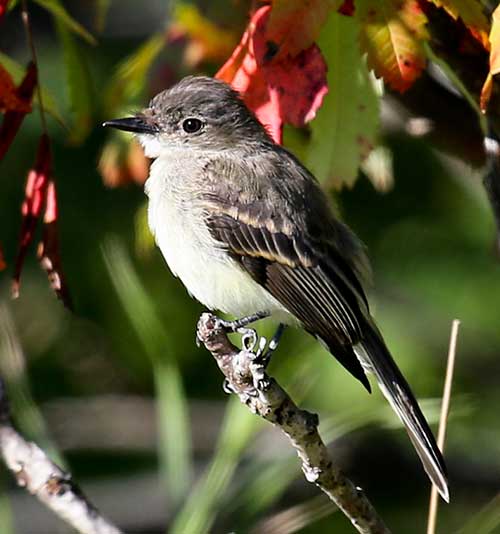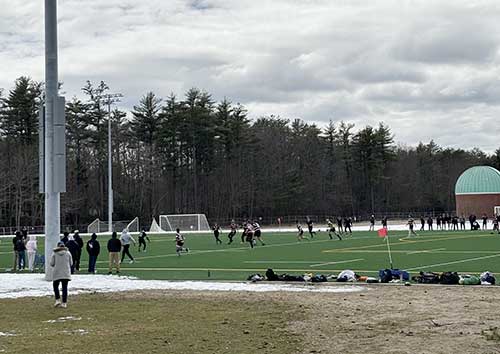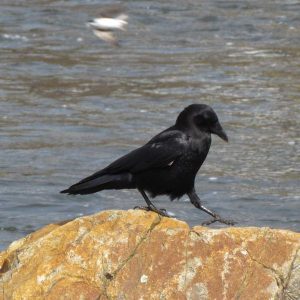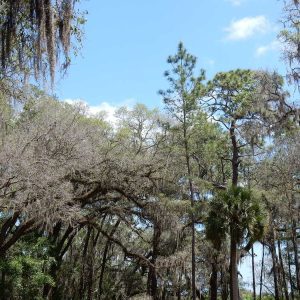
In the midst of a ‘fishy situation,” the authors heard their first Eastern Phoebe of the year. (Photo by David Small)
A week following a spring storm that left much of Maine blanketed in snow, we found ourselves at our son’s Bates rugby match vs host Bowdoin College. The wind had a bite to it, but the pitch was gleaming green. Soon, it, along with the players, turned muddy brown, and the air was filled with the sounds of cheers, yells, claps, whistles, and, as is often the case at a rugby match, the thumps and occasional groans of players in the thick of play.
The birds, too, made their contributions to the soundscape. American Goldfinches sang their disjointed song. An Eastern Phoebe called its name —“fwee-bwee, fwee-bwee”— our first of the spring! American Crows chased each other, perhaps dueling over a breeding locale among the many tall, fragrant white pines surrounding the fields. They gave their familiar “caw” calls.
Then there was something different. A crow call to be sure, but short and nasal. It was the distinctive sounds of the Fish Crow.

During their son’s Bates-Bowdoin rugby match at the Bowdoin College campus, the authors heard the distinctive calls of Fish Crows. There are only a few localized populations of the Fish Crows in Maine. (Photo by Allison Wells)
The Bowdoin College campus has been the epicenter of the Maine Fish Crow scene since 1976. That’s the year that the species was first recorded in Maine in the so-called Bowdoin Pines adjacent to campus. The first confirmed nesting in the state came from the same area in 1978. The closest known nesting location at that time was more than 100 miles to the south in Massachusetts.
Fish Crows, close relatives of the American Crow, have continued to flourish on and around the Bowdoin College campus in Brunswick since their discovery there in the ’70s. For many years, this Brunswick population remained the only regular and confirmed breeding population in Maine. We remember how excited we were when we visited the Bowdoin Pines and heard that distinctive, nasal “cah” in the 1980s.
Fish Crows have long been thought of as birds of the southern U.S. If you’ve ever been to Florida and paid attention to the sounds of crows, you likely heard lots of them. They range from eastern Texas and Oklahoma east to the Atlantic coast from Florida north (now) to southern Maine.

Fish Crows are closely related to their more common cousin, the American Crow. (Photo by Jeff Wells)
In the late 1980s, we moved to Ithaca, in upstate New York, to begin our graduate studies at Cornell University. Soon we were delighted to discover that Ithaca was another isolated Fish Crow outpost. After a Fish Crow was first identified in Ithaca in 1974, more birds were seen there each year. Breeding was confirmed in 1979. Like Maine’s, this breeding population was more than 100 miles from the closest known breeding location to the south.
It took a few decades, but both here in Maine and in upstate New York, Fish Crows eventually began to be found in other locations. While still decidedly uncommon and highly localized here in Maine, Fish Crows are now found in Portland and South Portland (we’ve heard them near the malls there), Wells, Sanford, and Kennebunk. North of Brunswick they have been regularly found in the Waterville area (including, interestingly enough, on the Colby College campus), in Lewiston, Rockland, Belfast, and even in Bangor, Orono, and Ellsworth. In addition, there have been one-day sightings of single birds scattered across southern Maine but also lots of gaps where no one has identified one.

Fish Crows are more typically considered a southern species, found in habitat like that shown here in Florida. (Photo by Allison Wells)
When looking and listening for Fish Crows, don’t let the American Crows fool you. American Crows can make very nasal calls during the breeding season, and, when begging for food, make all kinds of odd sounds—it’s very easy to mistake these sounds as those of Fish Crows. It is helpful to know that Fish Crows give a two-noted “UH-uh” version of their nasal call, which American Crows don’t ever do, and once you’ve heard enough of them, you’ll find that even their regular, single-note calls are distinctive.
If you hear a funny, nasal-sounding crow, take out your phone and record the sound to attach to your eBird record or run it by the Merlin sound identification app. It may just confirm that there really is something fishy going on!
—Jeff and Allison Wells










As a former resident of Wells and Kennebunk they have been seen great story.
Thanks, Fred, good birding!
I had not heard of Fish Crows before.
Having a recording of the difference, or a link to one would have been very helpful.
Great idea, Bob. You can hear
Fish Crow here: https://www.allaboutbirds.org/guide/Fish_Crow/sounds
American Crow here: https://www.allaboutbirds.org/guide/American_Crow/overview